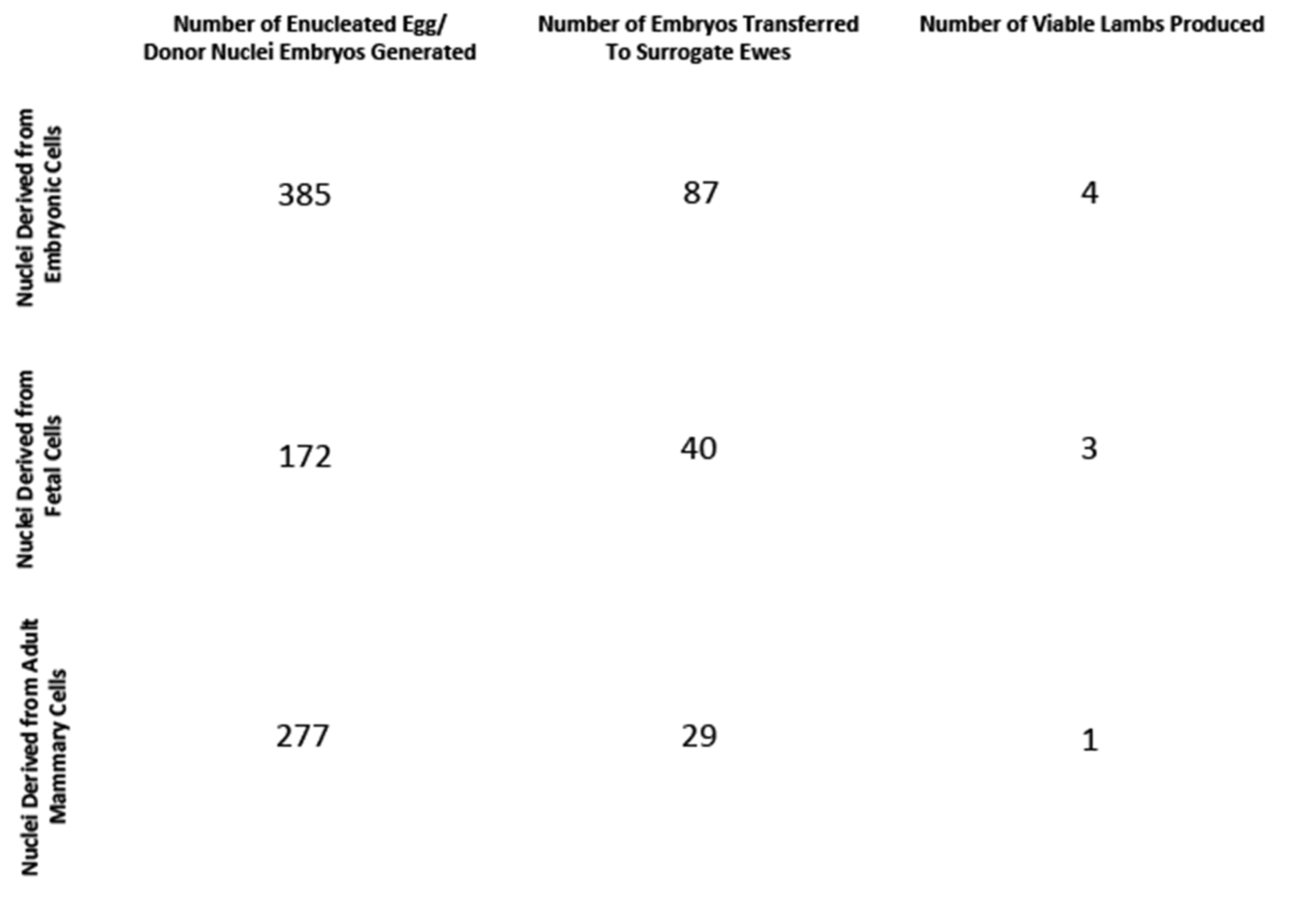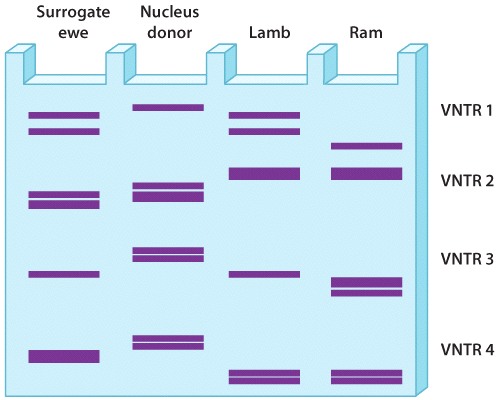Chapter 1. Mirror Experiment Activity 20.2
Mirror Experiment Activity 20.2
The experiment described below explored the same concepts as the one described in Figure 20.2 in the textbook. Read the description of the experiment and answer the questions below the description to practice interpreting data and understanding experimental design.
Mirror Experiment activities practice skills described in the brief Experiment and Data Analysis Primers, which can be found by clicking on the “Resources” button on the upper right of your LaunchPad homepage. Certain questions in this activity draw on concepts described in the Experimental Design primer. Click on the “Key Terms” buttons to see definitions of terms used in the question, and click on the “Primer Section” button to pull up a relevant section from the primer.
Experiment
Background
Cells derived from the inner cell mass of mammalian blastocysts are pluripotent, meaning they can give rise to cells of any of the three germ layers: ectodermal, endodermal and mesodermal cells. However, as development proceeds and cells differentiate, the ability of mammalian cells to form different cell types is drastically reduced. The work of John Gurdon showed that, when introduced into a naïve egg environment (that is, one where the endogenous nucleus had been inactivated), differentiated nuclei from adult Xenopus cells are reprogrammed. Not only were these nuclei “reset,” but they could also effectively drive Xenopus embryonic development (see Fig. 20.2). Could a differentiated mammalian nucleus be reprogrammed in a similar manner and produce a viable adult animal?
Hypothesis
Research carried out in sheep by Ian Wilmut and colleagues demonstrated that nuclei from embryonic cells could produce live lambs (especially if they were derived from cells in the G0 stage of the cell cycle). Jumping off their previous work (and the work of other researchers such as John Gurdon), Wilmut and his associates hypothesized that nuclei derived from differentiated mammalian cells (in G0) could be reprogrammed if inserted into enucleated eggs. Not only could these nuclei be reprogramed, but they could also result in progeny that survived to term - and beyond.
Experiment
Nuclei were derived from three cells in different stages of sheep embryo development, all of which were in G0 of the cell cycle (Figure 1). These cells included embryonic sheep cells, fetal sheep cells, and differentiated cells derived from the mammary gland of an adult ewe. Nuclei from each of these cells were introduced into enucleated sheep eggs, which were allowed to develop to the morula or blastocyst stage in culture (recall Fig. 20.1). Embryos were then inserted into the uteruses of ewes, and these surrogates were monitored for pregnancies.
Results
Altogether, 8 live lambs were born during the course of these experiments – 1 from a nucleus derived from an adult mammary cell, 3 from nuclei derived from fetal sheep cells, and 4 from nuclei derived from embryonic cells (Table 1). Through a variety of means, researchers confirmed that these lambs were the result of nuclei transferred into enucleated eggs, and not from the unintentional mating of surrogate ewes to rams.

Source
Wilmut, I., et al., 1997. Viable offspring derived from fetal and adult mammalian cells.Nature. 385, 810-3.

Photo credits: AP Photo/John Chadwick, Duncan Usher/ardea/age footstock.
Question
POJjl2uub/dUZ78N9fqGrJxo6IiG4wDRMGfK2q2PJ+4yLjArHkAZ51znqL1DDkHIYywzZyV1oQfjr15wO9fzNOV/mJTdhUK0h7qX799z3HyYGSnB/qOE8fco9mWV1mQ4IuKoqXLLpMuBy4TcsWw6IK50tRQbThs9NPpigRv78lHKN21FsLt1bTgrmQJdLN5hnOG5hAFeInZWlf7+oQH6e5BST0V8z6WLQC4LYqnnb1LbpCuMjAC0vowb5yPiSgMwWmqR/H1YQSAjJ2zN9gM06uGVM8ZVP0sTEz9Sd8P+ebTdh2uXAUZ3BrmFBi1BerCSDEbUez4+hVQggf6a9yEYeC481HIct+QAi+Uel+HNBw2myIGckDIdeLwt3didgnyBqTWDDpcPaonDvTeP7ioS9wFk3Q0lvvyRjjXtVez7E1++oVNkUNui22TEbiw5Vwi6U7XkLW87Owda9P0lFJR1BL3CAs9oK6zbVxfw01rsXaE/qwgMpEels/ktLZY8mJ1geC9EXkWlnMfXSX4ayYvWj1lsqOFxrmWuN2x4gizcvj8a5b6qdeTP/bGxc8HtCcEABdhOOX9PsZAW3OBN7hpA+k9j+qefyfVejFkqn/sHm7+9+WYWrI9ioEdoCiPS4EkHpRQpLFo2IHeh7L51Gp1ErCSl0X5TwyCgrjmi+XhiDX05I0EVnKb3mgR4h6W5kEhyGSiTWQP6n0axGyI2XoxlvvyWcQ1oFlEv7D1gN5I6lUkBKfd/ldOgAe6x/VvBA4ws/Qe0sr4ooT6O6ybOQ66dIUXLYQ4SvFrq9kmiBgKxEIYMPlxwAHOTP6vMmmKMGl6HgehH37EmGG1hqiQ+Q0e5JI/YB+l3mDjAdg5xhQRVsc2qeSCtBrnMFtszO4cWJ/OwO6yVUMnWNBelG+apW7ZbXFWD4vPVAzbKFd9OUGSnvX1s5M+wTLe/ekDvf9mltu2SYlWsffTpStZBRl9KiI2sUOLTYPy0uctoDBnHokv6gRMQfxvjg+xucXWGR+5Z/xnE3Y9jk1WgVdriNTj/G9ZC8NiqvIyzT1tWhIFymn8Ob4VhA2UmAqT6dt/lqt/mV7vOq5W99wMBR6OLR6Ti86tIbhGoMVgaqpDvfC3+6um9H0dakrPliDOJ8eR/QMIQqKXCHbzXjzlPdH5Il3yz347p2K3XqzqQWGb41jby4aXYUWlG9qirS9ryYyZhv2bqUuItNQhCcTH8qpCoqyfn5VFlNon7QdnEvcbbYwFp+nC+oRLlKbPXU2v2DX30JN6k/CVCbaC60qm6N77ghxgrdqlu8qVPnGoJHUCTbTzqsiZBypXzXGIVRb0NthR2clV6LGU6v1YvonZjbiCV+T9rlpaiCVhgj9QlJdSJXeDxM/5Bou6RJ09UNudpt7EE1aW4czqfqw/bxa7//pnfCgIKNrI3O9wMd3bg9gIa+8wYcGHsEnBkFORfh2m6iCEG/xbiot7bc0sYMYii82R8MjKnCRi5aj7ajD4gHEpTsFL1JNJJlUgKIj1Fem4fFY04y70=| Control | Operations or observations that are set up in such a way that the researcher knows in advance what result should be expected if everything in the study is working properly. |
| Positive control | A group in which a variable is introduced that has a known effect to be sure that the experiment is working properly. |
| Negative control | A group in which the variable is not changed and no effect is expected. |
Experimental Design
Testing Hypotheses: Controls
Hypotheses can be tested in various ways. One way is through additional observations. There are a large number of endemic species on the Galápagos Islands. We might ask why and hypothesize that it has something to do with the location of the islands relative to the mainland. To test our hypothesis, we might make additional observations. We could count the number of endemic species on many different islands, calculate the size of each of these islands, and measure the distance from the nearest mainland. From these observations, we can understand the conditions that lead to endemic species on islands.
Hypotheses can also be tested through controlled experiments. In a controlled experiment, several different groups are tested simultaneously, keeping as many variables the same among them. In one group, a single variable is changed, allowing the researcher to see if that variable has an effect on the results of the experiment. This is called the test group. In another group, the variable is not changed and no effect is expected. This group is called the negative control. Finally, in a third group, a variable is introduced that has a known effect to be sure that the experiment is working properly. This group is called the positive control.
Controls such as negative and positive control groups are operations or observations that are set up in such a way that the researcher knows in advance what result should be expected if everything in the study is working properly. Controls are performed at the same time and under the same conditions as an experiment to verify the reliability of the components of the experiment, the methods, and analysis.
For example, going back to our example of a new medicine that might be effective against headaches, you could design an experiment in which there are three groups of patients—one group receives the medicine (the test group), one group receives no medicine (the negative control group), and one group receives a medicine that is already known to be effective against headaches (the positive control group). All of the other variables, such as age, gender, and socioeconomic background, would be similar among the three groups.
These three groups help the researchers to make sense of the data. Imagine for a moment that there was just the test group with no control groups, and the headaches went away after treatment. You might conclude that the medicine alleviates headaches. But perhaps the headaches just went away on their own. The negative control group helps you to see what would happen without the medicine so you can determine which effects in the test group are due solely to the medicine.
In some cases, researchers control not just for the medicine (one group receives medicine and one does not), but also for the act of giving a medicine. In this case, one negative control involves giving no medicine, and another involves giving a placebo, which is a sugar pill with no physiological effect. In this way, the researchers control for the potential variable of taking medication. In general, for a controlled experiment, it is important to be sure that there is only one difference between the test and control groups.
Testing Hypotheses: Variables
When performing experiments, researchers manipulate the test group differently from the control groups. This difference is known as a variable. There are two types of variables. An independent variable is the manipulation performed on the test group by the researchers. It is considered “independent” because the researchers could choose any variable they wish. The dependent variable is the effect that is being measured. It is considered “dependent” because the expectation is that it depends on the variable that was changed. In our example of the headache medicine, the independent variable is the type of medicine (new medicine, no medicine, placebo, or medicine known to be effective). The dependent variable is the presence or absence of headache following treatment.
In designing experiments, there is an additional issue to consider: the size of each of our groups. In order to draw conclusions from our data, we need to make sure that our results are valid and reproducible, and not merely the result of chance. One way to minimize the effect of chance is to include a large number of patients in each group. How many? The sample size is the number of independent data points and is determined based on probability and statistics, the subject of the next primer.
Question
VBT1F+1C9skLQRKnXtZ72ZOL84eaPCg5z5XYy5HID5mX+keFljh2+z1whpOpyl0bU82wlrVl78sHCdESFIYtcpKWAjzbIKr+tvGtG/Obgdb622saBL/sTfonXpjF3UFeCxmUpdHUFJxwYRev/uPuPQIRc4dHb9/yUUChFUawe7JNjFlAVQdf3FFFl/Ifs8AI1wsPfb0pKXsQsIDWw4sLsUVQjVo3AyE3bQxwFGnoTQVNMhapexShbooN99qeFXWPb0LbV8TUlu5S+6rhSr4lhuO9oiUK3X038r8JKh2ORnQxL/VLg4iZduilEc17YNlbK0BGpo8OjG8XTrWtCP7ZfySjUPbHdtsF58mw2cbo4yrAp9tIFJPdLZVSIvNsTiLlsRsQ1VCP3LTWamE+qvuAYIEFN0k7pbF9mtbE0v0tPlkeoGTqKWoRJEl8v0DiEXpI6ObCz6EUO3zPAB5LMoIR9hXyYk0lV5VckYTvBLe3dNkfO/LTHTe6eL9cvaVLbPXFHgtl3unR6rPNjoX3g2nAe9WFzACaIDgSH5C0gBGkqkO/QMj8nvnq38V2+pyu8N7sL6WTWk4VYuygKcvTn5KlRZfq5wjJDROduwC2v2AaKAF0iFNYP5ys8Ag843QVtQdF8OkfWNzbe/bElIaQ1SmTzIvhjkklVkFj2RYW2lTN2UooGWKXIaAI8J3SoEq3655zJSaOjEZGTKckeIwrHJUnrE+Jr+xf9OvhdEA2Fym05263LjiEIba5Wf1EQyXGlBsYVTMmOIUyieWQa1eJLI5bUarxZABIxUh/XNimGv7rGTPL44Kcaq6NZTIFRP69DENZuCQvHFSNYECrem3jQ0W7TFaPQr0D82uZVNQK72XBab7h0KialHqV2ToBA4VL0SqfZhAZWsUk8HFIfFKZ9sNt/jm/+GLN/4Z7fayt826yz7XgjuQLjAH63GpOXAAVTq0VX6HSnHm7uTdT2A/dc0xJy7zxjwC+eE9C3H3QhI0GPXuMGjkXwI15YEm4NqFAcGk1vU4v3aCVREjQb+Nw5jVL6PI8TKVvvf/0L7wVp4WRGIgpHOQQybVVjIucEHW2VS/afH4Kie3/Dw0TaaTsUpSbPcVHUx3CT/Byhl8Vicbpq+OVK+NmwyeAiJgTWHe3f4HWDgYUstjpuZnW7NWemH0+CuLOAd7x3uAf4i0lW28WbsuSH7m5gm3KycR3REKOLBNq+Ocf99RQd+z0HChxR7A5rlUT6PTQc3YNFWDLjqBNa6B7VTj+fj4n18MpmBD7iuJ73hMAzkec6ctkJ6xY72Gr9rKuJeCBVC4+VgEJWO0l7fyUu7dkUuJk//CyjGYVO/mMjFrzqx0lpVMtLG7GTFGuOUJ5Pcwxh8CD06gAnF7GSd5k9XTDAdr8H0/BCrAHOjqSaf4s/NjMA4QcBUSQc+PDvy5E/A23wUcIuGIR00C4PG7f0QiBfD0GQ6LWv5oyDJ1eGY8wHpZ/+0XhkHipoqV2J0oLlWQvN7ZJQJi+Cib0z4sw29mNH5Os2mnd+kJvV/kRTx0vchbHPYzNPksbdgo6a6lWcOwPS3LlZn/CvOo170wK6wkpK382JdDOW6F2L07GAS1qKZj42kuhLFIC4RYqJ+qN26aUMEBZQuestion
CWFkUABCYwC4Y8z1sxRryImxWqXjVB5WRlvve1GyCdFgxTzBWaAGzqy36knK+iWFxTJgKYrkkfQQHOuFEppH5RynAgt9bVztV4qJW7hWvgDlnY7faNf+BTa5H790faJsaTap7WF2C61ZZv5ztrb7Kj72Tpp/U3Sf1Q/Rfs3wCx/xXyC34WpcJVakntQolMV5DfmzgGTtIgLoiv1HbbL9scQbpANVr7Ey9b0ckzvwieHjsYJ25uAq++vipcTaAlPK9agQrKH++ddsTCKTHhafB1TGJ+SKcWXm+MlSW8V9+PDDvIHh/a87p6fv6meRE4jBuypB4Uyutq7R0xIO+dj1w0HXsFE+XWVsFbU5saX5ALbkj0VKalZNEIpyCPLIKnofBTF4If/ISEvcj24azwK5Dd40XLjbaH3d1o6lozbBFraRIkzaUu9fYAjov3twMHvktq9IIaraIAHG88ipumAQGapShpTf/4E7ou5q6NKz6ksYT2188oQ95HOr5RUsEh95Q15zzrdt8jkhVgeIRv+8L5K/VigQ4ax5HdkUiEVen1XZ9XtOMupAdM0tvUBpkuiUsbPRPX47pdkurB+Gb9mMMYmmxU6PjIuw5IygY6jf/Rfjz2mOomW3fpEt7nEbPs+ygqZPAqvRgvMWDlDQeefg54lOx7UGLFfvnYBaQn1uAfYiZQRGu+4SXLY36Gxuir5Bg6VYvkXTOsO3o+XG43M9G9vmcC1gTFfU5OzBQa05ifap6r8SGn/f+FeQSPlulH4gIykmI99ReWCRYGpacgLuJN+YFaso285cOFo+nohKKB3BUCJ0D/ypbEQua8+XuziZj5sQVGniebmtFNeDIw5df/39Z8L1LJ/ejP286NRjU9TGjphAuuQ9P9Cf/owH7iny2whKjA/Pp7Ypx7nC3GXDCeZywbzv545zO/dqFSOG+JXbWiAZfiuwDk004CcdfAXH6VyID5KjtXFvwi2yo9N1HWhy9Ke0n0QYpdHx+2SZZ3GKZKVI+r8US8u0YJVsfH/ZLOM0NAbz9Jo4BPS1eQweZWBrYZTM5yy2ljj9rGkARIu2sUR12BMOiqJpCIxBsyc0t1McqApGUpZsd7BW+QRh43yo2fAmp/JFA4NgJ5wEUit3Y8u0d62v7OD/5Orp6Z/SbtrwiUKh6x5swUtgGPkvpP44w1ZGZFYG09urwxHo9Ed7PQPqUiUxx43der+MY7KyxpnaMxwRwVbEPDA5dmQXm5PwJZ0QYFucW/FGh07P0D/75ZEFWJ2eMltJFJE3lAPfNLl4iIXT2i5/251aRqNv+ecK0O8ID6skTvAUhLDIIttChqBv5Ufgsai3xOgKJBqhAslOLoTib+8c9M8CDXaDrHzlHWF6LBnDmMCVZ+eqG/PiDXGigJ4ks8WGDVUgLM7Tf6Yq/BwW0MQyGXPKec0A+eavcKLmyNN0tshEdCV0ocAeHpTHaELFxlLYvknytHG3v3fAO3+xKFX2/5pbOPaG74vsR3K2spGg455GJQGoifNTehToCc1IYctz1SSejO6Qayx9fz9Yup2J1zTlKnMOLVhpGrIDx75JSsofPXrYwLvQBawBvUXZvUAr+tCFjNIQnNNLmPXVYHaVIz0F+KczIn8N49ISejTdRbW7Vju8/Ae7cXb6O4cRB/32JLmnSehiTwfc2WgZlL4hoUiosswu4vZ/pyCzeEcweyGfrwxS04VB9xjuBijfXIoLnY3odO/bo6E4z6Q92BTPuZaQDnhELPJ46VFGHjXVcgtbU1I1XW4DXMk4ePr6VyBjOGLEol0AU24QLtSpkK94dzDTdhlgKWCVj0zlCOQJ/U5Fb+w8HzOq5K7qjYGdxrwtGdgT2YYrOPesbeOKlnR+DrezuM5FvirmkwdH6r9PxGTDZNGAnZOhRYNwPctQvVNvSX0nl7rMOrSuZmicVUOLsjrcBRWVtZjY+QvtsZzlmWwdLaAtgjKWNa5yNqMQqgYO8LA5POBYf8abSvPg9PaPJTWjSbshGNECueOwJZHHNC2nLlYg7rSWaq7cTMa2bU6s24AqvFA9bqBGbt6aEgOjgmWZTmIXCFa2oY+UMx7Vyq7C2F62GcxW4v9gn9RxAL7cW47YluDaLrxm39T88/UqW+0MK9b3S3+8zOG6LkY6t9FenpWbVnIeZEaaIcif+bRvwYLv265y+k3ffXavqUFJHzkcbU4Er4TkqOxfuAvj1lnEDucw5hI/30ZHpB7OOc3jE3npV+e83/JB1GgSnQyqtcoT5H0/FAe+6ZsYdNjW1OfxGzNtaGHXtT4boiWq1X4wi2hDQSWqTk0PIvUvMzUwd6Ar/zV0lcJLG/duu87IQd+xh+uSESIBv4Q5OYJbSnL7jGkpj4jw/T8H3LVD1zuwxbVBO1qJPAiiZgPSiHVI7g4LdjyCuy2tBILIaPMrpAcLY6o5NZbOB7tbtbqz+v502kmjTPh7H6ATIBsmQBU0mVP++jGK8a57mTSjTZ04AyL8VWyS63o6a1MFuD8WifCIZMr2tGlZzRRRR4IlmeRY6akJbcHwRJ9uW1DRyrnJh+mc/s8OaWXXTqvjVo1YuqpPZ1QZ+uR3LezdBIJJDKUf6Og70PDHA+hqOuKjqCLrh7g0whTuESVFMjM9aDThUNSfdYlCGaaAbXalos/1/s0BAsJ/VIuX8SgXHB9nVJGLI+BFmwr9nPjHLASBBreXlp/R0FSSWd5omLyeEH+qHSoJ78moAnjl/K3qqzpaWZk7VKKL3WVWxgCChamY/neOAsRFSbC2UB98vqo3b2oO2dVZhZLGTune7IKGmH+OBqTHtfNNXXxJLKbXVUGfyBKMfbI6Kivg0/5tmCIaFO3BYh0OS3320F240fCQwCBQCufJUlqzcyhcJa+AFCHQbwuCQWlWGT3t0NchuL4PyCT6OGQxT2b6MdR4JhFLdz2zL9rkWP2cndzDVtdnFG7YNaZAf3scaUC6MTQUVCI932VQH5aW9Nqo1Tkis/CAohRG56nEkhfPlBeax2wTdyH1PBo0QjsZumMtzpL69P9HxT3hQGoTBxu6cw==Question
Y6/o4CkWT53M9Hw6kCudzJuLj8A7yIiBKNtctVGI9MqR34lRG0SGPvMMmcy8uyZUZ8axXVtVo3DcUczVYc3NfcqEWU9xm/ig3pnDS96qvC4WU3/2LQe5SM9AAHzzwpQbtM75MUWFCwlaGTkeRoUXb9BCC6UwJSaUTm6lQZ3IFRE8Da1o1c2N7jkT+6j4Pud9Tz3HPnvFXKQEU5QKm1A97ZZoM3dlVlo1xCbV3AFJstpDkwWjj1oYNbKV+GJQx4WkyWSp9XCZmzzOO54a3Df5rnxAvbNVPHwWuuh743054p9V3wKX/6FSSL7MucCaqM7cb/mwtvXfEKbP2J+M2Mgg/zuR9ZrAGN1tMRT2PPhJHps2Pgt/vtfedXMxUgyl3nq9nG1jSKgZvPJaGonocNw5O3JbeGBqEToOpHS0F6bANhASZ6FAUW3LeG+8PT2pU9GWPezfZm9KnCjT7G/vBTuF9eD1+s0WEkyNQ39zdEnY6M1dTkbKp8QdVq0WPmtvLj5NMQ+CwuP/ihXdRXqDRLHXufCMFuA2Rtgm55wIZ9PEHL88SSz+pFdRHsQN0wpt9Gai9YwD+7lT7ngYu1wvM1AThp47XHlXRyQo6AbU8QMjiiRrf1rLl0IaTI0pJFyy8wO5np9l3LF3IcRoKVVuwI8FWX8x8Vn4wjxGIg1YGsxqN+mltUjYwI7HMMKP1dSvrDeZDL71EOzjQ/36d1f+J3gAlXgw7E1lFwHZmub4zkNz7wJFg0Etf66rgjkKrEzFcudCFt7dV9aAeIMl8rrkv/jf0+mzERMeE/vk087zdPonsNj7LRjeJnzoN8qOwBRDQVEE7odXqIOSOnpdqZ288EI0sosgRQH5lTt9ThTCJwj0JjDlvAB9LciF5DuyiA29wJPEjKyj8jUc5G3orZyjl2Fy9JuvKk201Ia6w8tBuS/2IuufR07ChW8EG6cRinf5LbIHx6PYdwX4XnHzy7Y0xX/7pcny/xKwgmpo7Zn7teDv68uUAh272/uhx5eeFdnTBoi+kBjUR0Ja2UVFcJNQhOqTZpjJ4JkMYwctM5ZbXwdkB4p4fvcqv6+7pLMyX1CtCfy7QOija3IQGSeDYWMdy03apZ3d2SzT0A16UOrnzaRm8wf7O9W8jz1C/38AqX8g/uB3C+A+Xwg2VwK9LzOr/zDwf/2a/mFXOz6/kztlS1dC8z3qmglvu9rtPoegUdjmLp6+KjQLXelXoiBCp9QTI1Tqr1VETdtQsQKraCYxIbyY52A6agZjFXX4b9U8rixj+/gtr3OSeZuBV+fOisdooPJ3XBmbna5Sz6Aysyz7ikGNBOfPAq7ErYy7Ocdzkbb8S/BGBg3jItMmA1Nc5TK3e1A8YIc6+wpFfl//FN5ICoebAtWu0vUw0PZOwfBxv3xOzNNi3xrx5ZiC34Dgoj/IHLdOoLgDs6ItTlphv+D9stVnSy9MzqNysj2F/6Hy4DlXYJkK+g2eyb82DWTRbFi4BrvGmJJ0S+LDA3hGjphdytYEBVCHHVaDwwoi8kkzpT5by/6ZgsVUfch0K0ABVBGcpR9PBBsP9pPTYOrcGOh/UXlJna1AroN3njDpK6i/ytCKMrgFDgA0Nj455VxBBLwUy5CsdcQnEomjRrWFjr8EO7p29T6OavEmp/kOc5mzfxD6nUSkCVGWjpo4zdNuUXaW7+DhaHGOzpt/9+cJdWBNy9cGYes4HiSxyYXjQDcuuri1PY//W8uHDb2TnjW0u+HTc2wmwnufBZqzynysE0OX+5kd9GYFDlp2pgNXPHWpy/dxpQYF7rZz0KLNFlkQXWaBiZ8NmYKRpBCNsCOx+Yrm24r5PJGpUWZ6K5QwcGrPyM23KIv/ynheMStZ77qWdliwMqYh3lAmUcErEv+Paq+cQUROkQ0yUBHKekA+eqBDptgT5uU8FPlXD1Z8UEkke+V59magICKVRD69cqFq2JXPNzSn2tSIasa0q4Zn8neN55n7aVYzjtIprdGuv7eblPRLaUjvSA==Question
AipQd5Wi/rplVFyTTuXhKlyAN1tofH7BZLQMVtA8QMRZFY+FMnOF1gBJr0d1OYpHwsb3F9xq27vhdM8j5qBsWjjunwbN8I4AlsAarH/DYaPYawEZOmNxT8MtRXk23IX3LFout+iSHFpUHS4QUudEsoI/VVrcvR0sBZjspOX5Zm3V6Vr4LH7T1IhIcnrLbPdQFMxYwkOyN8Nhd5p5bu8kUeDWbyJ7Tw52nXoRGOk3pAECReNrYw744VRwYQJ8QkXsSosFhdcb2e6wjqCM9aFM1iFNv4kP8E0c7Digvv4F/18CV1dr58KJH7aj6tu4O80ZDejv4hp4kypieCfhzzaQacx4v+OXp1mQmEOIJZtv3WJ90XPzYZiGhFE4wICL72sEpeqBwHX3rwt1S8thpR55tM3znDkixpTTKeeRRq+kMoXX+325R1iDDOwDoN/RtrmfXV1cT6MIrx6XE8Rj+DQm3+8sZ9b1jDsi2sEbdpLNDLF+tysOhE2E2As6SRpMMvSEwD565nyvWTNFlWLEvTexqs7S7/5aNgi8lc97FAyXxOwn4rpfWF/1dzwCi2qrn+eEALIqQxVJZEB5jqYG18gF/7iLGNJc3zIIb3oDhmaNgDfqAz/VCR10AbVQ8obXS1XyAZlzVrxwkTYICG2ANBzLlGc7IBp3ijnXU875NmYPfETKGypbKG+wasGy6zgq2LQtwXE6hPL+fNcK0e5T+6cV3PJZlHzw59BaU2ZOKh/WPUIHOFXdmWFwyR3O2HuUZu7VxuqTIYCb0F7qmUlkaztEqKbFk6PwZTXRP3IUd5+nlert9WiJ6cwnZ/4niJtZ5k6XgqPSh1rXpAchFcDxKy+u9XZh9K59a/f5LmZZeK+vCIUXTgl0z6pm5XWZXPEfpbCd7baMpJuMgpzi/Eo7lcMqN2UEigglDFafYLop9YOcFd1TigqRLqyBxxPlc8tTzrL6HHjIH0uJZbDUq0g/nqrIyzW6UqbLvHlVAJjjfgj9TdduNmlLQOstaBxKjG6nVGHoB/Z36nbzf+OF3dCPEqvA4RSLlRKv51eKJyE4i1jlc9HZBH7d9367+60fdcQJQCM+hSrC9fw0mg8kQaR+TIrtLqKk3t2seUWdynWeoJKB6qCqgN+18OWOY51rZ5wtl4cGznKQ0TleE49vFFPYpNa403rBrW7JBJWjd4xYmtkEGLzMmWDBO5rMn3+HoXVsme+KKSRvPQgGUYBEkOLKEg7nBY+WiDybMHIMbNON93D//qjGEHly/npypN/HU4qy9jDXWoEETmE/m5DLc494SmAJvhRqSJG8HISLrPseBBeftaAQLbtUhLGpWL57wc5bU8RUGV7kxySFgDLHBoYnHUsKbpoxhfdo3U8eP000u6ap38bA1VpEKoXCXnToEOm2zmU1rxaykAV/B7tACcjCK1suZ2UhuTJsIhMnaAomN6VTZCcdWeEAatmBJUFpVv4+b/iM4tXZxMy/NycXs/ZwVgH21T+GEJJRTaV8F3AjpN8kSDC5YZnw/JNYbQjgkhvihjajFDfxr1uFuhwPpfhBPE6zoqnRhQwuuzYL9MjgCOT9R7E7EZZVTnXFh0ON6VDPOniova4a0QcM93P8Gngq8JV1+TpRDUFnrk2vKwhNuBoQ/SeEjPxqo5TFJ4TeqwaA0UUUBtvtKHjp48NZnJlBNpqEVkjDRABcNK2xxva6OEDKYGMgnxECC2UwDFlppdzdioXainRKkEgu5kU2HMtBhbbHUZTQmSprzWKfhdOqt1BZDNprozAPtZ4q9QaQSQMOoakdJgDSb/9V7rZetZC0l2eDNjLtVBoXdrqcO9GwRjvyd/sdJXsGfp7CZhI8wxeG2IuLK+fFrGAODztkWZxT2nuxElODHpxWwQhlYdLNOdobXh7RGYptjsdCxptWFghmK1TL0BYhuaxslcCB7J9VEFW0GDYZexQuVOXdOrALDIuf1Y2x4G/wL6tHizmLctHLGvJf1ih2YPJCGlrhHzZoiBLFXzLMzSinOzxZzmjdpL5NEu71B4CZqBi+F/icOGQ0tgenmYVIMW0A0UUPiX5wGGxx7KU3EUZAXzbzwppWwDwBWCJX6FHYcEBa7nGc8sxD2CS3KwMLprRmpW7BB0bt9HFVZ1ZBzD5E8xWHSUYlg+ck8hjSKxgVvCeQbq5kvcU7/TTvAdsBVQYa8SqthRCBzIY87AY7Jv8Et0C2eHjMq8bg803L7KF3pE9KqctdP4+aw8zNWi4E4ySbsX7FKsS9gF+FSHL9lGrtbcEdoY5na4yGRUU7jgYqG8LlygNNFc7+c0lpTKF8uYvNLjGQWPATeBH9GvRE3h6z85EjaG7FpG7oYYKGEzos6cVNHDMCtPc2pHhwBoNTXwNXTwQY0pdVkR6II397MnZenJbHu+YPB1R8LJb+COMRVkPcBurkfqaLNf4POUh+FOnCdJgkT58wVyXWNXMAa28bCNF6hBI9btC1thkk0jpvCo/TLl+z16njgYSKk3kRDafaa4spxybz6uqMggLYYOLNURQyEUqQhe0F7WQqbLkucjy8nCKTbIg7v5EnBOBfMPvkDa1Mjto2dylR6w==Question
6/YWfK8bPoRrcVtDX8c9fCzmGIZWT28JZS/Dh2u1qczjzdvDh7IEkGM/HNum/YUUOT1SH1AhN5CpwwTSI6YBZBevio8ZkEPDjBogfH8SDFcoDjBgnDPs+z23L/dK6m6gXcJk5p4i9N1iEuXVBdTmhDavc/BwL3mBZdJ/uFN3ol4v++dZxvymvEIEpKohTWnlS0A1BsjgdhBaJUcEr0t9w7N5WI9v16Md4FLHPj56k0DCbIClIZQE+7FegLTkk3W8rB1nAdF7AoEiw3ThCJSJnwW0vkJBuYNKiDMY+f+vpMWxCqD/FtQuWVM6n7o6xXvknlU6IxeJ1QwJHkKe1Z2ULUn+4RmkfAp6uz3cuGHGQU8rQIXf9QI/D7BNpKIWVAQruMj8ienfU7Pxhay+ZejmMXmcxLfn2ZvSx0ivlZLQ1t5VQ9UsbEqxhWciozKaG55reJnj526ctn+R1kSXjbI9RZtbNk4I/TIqDufWTTTDnVfPw4mzf9qEXfeG33L1bozXa+SH+qve9/6KvDRw6GNyKLcHbKWnn8JMQRPKMXeFBsDL1tlID4l1iT8wlwNennOmVM1gYYF4vDDjVX5azl+PI7ZBZW1XeiDD6xZGeW6uOhAFBebeyCK5b739xTnuIT769/QQTCxZF4eEY5nDPwrVpFqtdCNrpa63s/A7OnBWqA8bjHFxYAAsqq2gp5bymCP0cV5P2CYhvRwXgsYUHxbjLbM/MfvTT9iH8fpqGDLW7E7ZaY5jd1Io/VmNLklp2LEEoZT7n9gf/190x5I3DHfUdWLR30w5YcrS/KhosUMWopMJzra32dTvFN5S1ZnktsqberRIQElO7Y5d6DL79UqhbpqlHzFFDzG1NgQ7+2u697YtQ+D6m4Xi8nIX72H35lPHSQk9cuwtmtjvNjP4YZ8rqilgBxQc9R/IrD1bPZpvqb9yWHPSL8aBKYDaeMZ39ILrjckUVp/u28MH6lyedazIz4YG9YaKtDYiR9Wz4bTXhZ8TsAEwPbyoGmZ99tLc9MC6zD+sYbp37wJLpjisVSDip0pVmOOJCxM9vo8GatgbRqWXPCD93VNEcfEPx1TJ+yDk7kVzaEnT7h5rNZxxqhydeC1yHuvf1P4t/V5ePnI3SHQpnE5BYCQL7ahIbsnXUXenFAEdbZWVMK850t10SStkHon7kKv78VGF2sa8QYQzceHRwjRZKV++qV76aXQqJ4MyT9dLVeFxK2czNG2MqjYyRQqrY02ckAzcWSNiD1l+r8agX4W9ZEHlwsvRVnjlYcxlxaEVZTtCMLDqqtOem1ThYpvIuYtRi0SS0vvEwJlXljYeHpMIxt09nVqUrsGZjCnWFC0qasmgfXNdaBjpJRH5K3T91K3yfUutwmreWUMgBl9QSU7lN55ZsaaMgA7VXEJgSLXabo0E3aDja9ruO39p8l4DCe7txMfnCJHjpLonLpRY5uSL//Yt7QdYmNbl7E/0mpPf4fZyCT85H6er5Mlc79LJ3CTKBsNA/MniqU7SprtiYvQHuAApnrZCwSvUCm1yFQWSVgNc/EMtczW27z2KFViOCWW1MPr78KK3mjn4+VOqZ7d53S5wWtjVv7dzmpDICH58Y6qixr1dzDz4aW/WYJLqXpCIcxGeU1Nzbwsfdjp7sREZz7o5VwG+2KYHke9kPJauBuTqY+wkJKqqKWzQiqch1nOJpmpHCKknSa6+MbOByznXi+aDN0J0vUgqWpctM96z9mhLgx/PNLhYxkjWgBNfpwalc2SsaMwT3EDbx5w//cGOBm81UL6cIOl0P1EZYgio9UigD/pu7SBoXdm3KRWe1t5NyTEIkx1BV1j3cQ14ozr3qVKtARz/GFMPxdsoNzMEV3dFZJtx9AgsqWtwgs0gPhK+LLlJwt9L2YTrAD5/K+KXmLxYzTZ8A4ORL+kWgXdAjt7yUMv5sRwMzGTNC4g6VTCwD4iIilKy/17rt/YHagYXDs1atlY739Qo26Mvk+HzPjdO0S0TWl2I6+UY0zTYssnrUGqcNEe+ToewD3lxCiiQwy7FayxmmIXoOFyy0Wfxu/IEqWLmBb5IeGZQvuj+kKX24iZZYmq+vO7GoRVCebEiVS+u2xC2MZrgfgpA6hl/aEP3u3bvk5vYZ8LNzfbATXb49IrkDGbtQD2TTtQlWSyTshLNnEf+pkxwu2CKN96OPSQPHLlHYevZrVY9N8MLSGlgOgFTX2Fzpb2dmJow229Tt05K2i44/O8qzZIeYeHTA7kSxjLaIwfIdpJcUU6GqHT2gL87nGk8YWYu8alWV0H5KOZoteR8/xnf/vSkAlio+I0aMnGTaiM6VsdU0YY6k8w5hOpevoIULN4O4TcQge0Tf1bwpWS6hP3hm4W+QWtWYXm0NW6/BsWYADIs9u0tg8Km0vKuNMz7MVVlQFkVlX0OtNJSzrDkKVqdKh9oo17v7k8u5IyRT6Rwf7xuV36j8+sXz26/w/lwp7sJA4Z+0mCDcmqhVi3/bg/tFrxwEwrPKJCIdYYuyUu2EbJpFQcVEJMq1FkFTQD2sRS3N8m4PMPkTMtkjaIG+VNUsraJhuF0Na4CLoDU3niBe6eSl7x9+gZip3b4OyKZp/kP6dD+bjFdBxW1ypns+qWg1QsNrzeY6rja99JTdxPLE+Fb2TvnLX/Bek01eKHTiK5r7jabSRIuQuestion
8FLxcGqrcBPRqqdsi2UfnazUZEKX7bN1BjYOdKbel3xr85ap1S07WswMeQ21LdsWpy8r5GSFiEleh2Ea6Z3mDE3P4wcBoxZg5JC65Rk8PYekiHno6qjpiWZED3SPdDejULKt53T1AAL6syeHxTBMGUvl9eWbLVhJBnHA8+YDwDrNczZxhy600w4VYV40H0Dce2VABTBgrX+j61UWGKJRcpKyij468CkybroKMxelA4obKmgk/DzceX2zwM0VTU/lgNn9WlKBUdz2zvES4YKA029hMgoO8QRcUaknD1He5hlQlYm/rOLqriQPjpNfoW4UMUpuFmBZ3Q1viRhKdBtcN8ktr1WzwzuWtkz9SN4jRtZRUJ8RXgK+2Zd+uSuOptPwzWAAaqFUdybRQ3PwqG4XvwtHnFzCEPpzcJRnB+mIOnA/etqRjJXCPopM9Y6OjL0xBx/VUyreRsjdUbQon750m7/EZMA9EjzE9NhU4T7upwVCxeyLzKwpopjVFbKA3wlXvO3U4imWb1PKfSGACKZYl+l7F+qntO/0hxRyexmRvxuhcVNHsRjMr9P1+94I8oIEuhOrBwgU4l19Xhbmi5tK/k0yLjh1EI/JnRUZkLn3PVTXp1CNrtoqMpI/jVfMSjVCkmFHzf1oijyvLqDc28oT4AxOhwrDBfH5lSWTuPb2JvMLSBYiFCa2ZpL13y4ITqcqejynKPBo5vkOY5Ues40MASiQa1XxB12lQ89ByHgzOhwA02k79F703jvhg1+kfQVP2PENz7PS4UEZ3S5st+V0TqM7bp01su10rtJEskshCZB9aTDL7EFpmSJmMjNh7VHqpISUX4wX2CHKUCLuOhITVbuKyV0TtNjhKcHLK+GdotBsyDDcAhUAdD0ryim/hyG1ZDVhp+bONeTmmhAhstdmlStQ58+wRqdyKF5RbCB6g1bkwAXw/bMvxpgdBhCnaIgdhG47j7eeB7TTTtp9gKhkZrv5YCIi+uM/vEQw10Anwms79z5Con5hjuPy4UzPACc7MSvO/uo28LJGkXMEeaLkrCkj28q7pYoLhHiQ/CEKbByGRx0cxzVKeCm65OUauOaaKKKFnADeU6g9LK4og4ZYXM07dpINGXMDW5wD6bQ8CN3GJ3G6OjxweQltEBq3NMc+AWoIC4RyUJxQjBBJ+AX5IWLnmSHOZhchc+bGrmnxEhDc3Yi7LQ95FA1R+LtIC4/pmkfvGfO1YIKPl+WFes+UnYgadvhsAETM0TnV2Vk7AJddaDKTdRxtIlwycVrs0btSCjXeBhDVQewtNXwCSi8TUhCHXaWHXwfZ2IqR0lTMvwaDS9PKfIdaX4u+gK9JgOqVf59cA+tDHg4fzOVfsXLljKCWA36MF+jodgLDXn+27EXJ8hcdKo5on5wVRdxMm5D4CuumCIax6mad1R9eNXmWEdXXFtIU8kZZmQzgAJvcQCWBx26uXUl1ErhXSCBDVshNaoSIv5H4Hg7AK2/N6eIA/H5GqRDVHqkY203bsCuyimFOP+gVuf7tOx0j/DaJuHYk/kpvEAEawpdoMHvbVVDoeemneBQ5m68ApIq/M6KYtfLAN27VgWCWr+jPqPRhC4v1Hi8bOxZaurd3KYldYlR/a58LsM7tL9+sOxmY9p3FNXsJwVAkUCeGLbBYZtv+4gYffNd/3OZRh/xwFG2pU+v+ECJWg2ubR6OHZ9Fj0mHnUcG9zw4eIcD+VcCXS958N4OpsINqsJoRve+uMzxQZcuq/2Fq4j39FtXIgTOweFkonaBzWVWbSo25N2GhX7agUPlBRPY/Uwjw77Ianj6kxlO3Q4uvZ9Y2RTPDk7DcItLiXPCdS6UR4g8W/oEQ1mwd+A/vaooBI2S93+OMox1tdMvwOhhGeLqlF4MPf9mleR8NRuI8lSCvR+f+BnJxHmY8HPM4AHfNU/Q+v8+36zG4NvUGj8NdGQKVLLM1JboCYHUiu+tnQqsGqZNPCwjuwINRfH1CfhzA/hAeul//e5QaERMiOtIvm70/VxPY25ZTIvZkUJVuSftoIXYki8p2quvx60EWDTaNmtcn1OBXyDbjtjCvStD1GhW9CY35eNj3Z7cz6uFAvXRTIOUJEuBkaBI/t92c9BxutkL/SvfgU/CHME0ic9Z5feZKCLu8bamnwCQP+fPqvgL8eN5PYz+eKkk=
Question
ZrAMAnrYbYbpO4v4bbbLaCiFtiyISrFKNsezIV4vYvT9egIl0b51ICu0S/3JFIapECiQ1hRE17qkfhIJjnSJ4IqcpFZ06gLQHZekEbvzDbedgVZVShWhRqUR+T3bvkzwsu4peYygO3AeXXztW7UejBBW+kQ841USoVludJOhB5vVCqj95jvx3FYb0ciWnosar5hhvChhLRsoraX1DjXUHtBpdz00Swe4iX7VbvawNpVJ5ApAl+6gC73yFOP4KPokRIJfXGGgQhv7MYa5DEC7v9+8m2GHw6r33VZQPn3Y0u6vKmBBozomQkQlac34rkeXmhqcMcrM0qAdmSKp6OhVhIOCc6+U0zdgvlFNFhYseVf8S2GO+VjzCKa4W4AVYhl/QW+cPohdCUgURuhiSWP60HveSOflC2xIqbA2cG9p05UVEtTsxTKhA2CxjSty6ZmMe1A0VzLztIuUmrkRj0v453todn8kEeu+iYlWk8ZV+fzIBn5Bxn2DuDAyiwjM7BmCvroqSn6+/9XZZtYHeNgHsJ8lO0ueIqQ4agRtnkuHNIAOebn6/06aEspmDuAtIwA6nnRQjzmA8i/Xd4St4JSWvJs240/9vLEX0SZQyfHGBww92jRvLhb5//1ou92P7RC+2CXduuC/fZSucaXSCwxPNYURvLF8C5joei0fIxP0D6ZEzql2eqdfKLeq5/7cfo08WI3HxFHMJLe1JgjXJKW5b9ZNvoO4k7sO5UbRr1u7thCyJgqBeKLZr0I38tjz1dp7gw3/iTTdKR1mBvjl90wuqF+WavYJ65txRA7U3mSMSVJYRBqkr8l0h2uYUdn1OIIs7VXxHM/TrIcp/m+kqH5llZAa34+AFeeco9JZeMT8St0mUhk/QLXL5+/nvc3DVavJxwND5pEY+akQf4a75twJmbBHxXJ0mqvlebVCjRqiyHPOKG0guvEOjWc+LcygoXxBAxQdaZhMRznWSJv7VqVUBtIIqmfNcwS9Djq4T8ngE+DZXU4wm8OQsPKJOVQL+4lydbNwQqla63xZ9C3S/pMrmpYEDlQPJsG0z5XXFqfcQjTL6bYDoaSeuPK2oyhV6XBnmc7x99Gax90kFuEW6JufCPxjLpwUxnXTlLTGJk4wX1rjAprQIiYZS0yUWFWF1DRes7XBNu4I5604cEOnX5OfvH8Hcp2N90GndJeNIotvV3H0X+7ciLSWxtGsBnftt+jwTS+C+njNAT2NdoWIxPeOzpbDL8WEv+iDdeS0Szs6DcKW7bko9A6hKIys8zEgLQQ+buJowvyXNnFuIAlQyFgvFWnyqydRlSetXB+ClkkAMCL9kCFdc9PSvuylPt2bJCYm1lL7rMVNA1At/QASNDTBQlFdPPWtwYy4YI2xT9pHRSfhHI8kDT2mI+ldlSSE+9DRHGuKPrn2MurVATsEuVreGSjmcvBCX8hqilu/t4pPKX1udqZTSvN7Dy+vQPrbw+15GuTR+MOJ460GenDSeuDe8ILNmKx66qUqwC2aTuZeNieHrYtAfq3Jlgupd0Qxs+ZzQJ+jQcr8u9WN9nUOCL7G6jCJUIQQ/usU7CXHUcKE5u3skaxL5OOITP0dSJAJbgC3PaF5NYd5Yh6MjgSqP5/GEyB7hwR06j5Wa/kJTnh2ha9wi28YFwSgMhLv9yHuProXp1QHUk4MridEMXt57DgdUycvdSZZD5OaSYdULgASo8GsF1VAJvZRMMFXlF14zs1cRpX1kuD5cPN6K6WUYAXx+J3PXTJRuTvG1y4iIXt/32kulajIQLtcZVimaV5qWDRiQuestion
PPIpBTxMiFgIVp7IqWkxKWKv7NYfLDfEW/QelqkbZb3fSmGRzJiLo7BsktTdEyr3CDdmq+TqvJCxlAHc5RhwHun22XRUn6R3AXGnhHnW4j35VLEVYPlrd+ASsBxVde/iG6h2PLGztI+bFbuTbMf1BMG8byuGHgB1iKo2DBx56VowZPE5/836xlNGUqV0JXtlStw0JXMzbA/lmPeLuNtrRQIQF36AZzgmrlwie5/QlnX+jTiwEQSFFxRME//5lC03nhpSHL2fULesHN/goU3TtmTDIO/C4BQDSqYSgRV0IIMvb37KFE9J8q53Y75noUYbhYtsbmr7cY+zbmBC3CBjDbpG7Y1gof5fus8/36vt8ndTP3WjReos/AxoW1G5k5iWqXBLXPsYmGg2G/94ojcTRHfGvWZoSMXFvpTA0Qcr33flTkhZQC7/3Xx7F/iECHwXrsnGwa7uG2+bUiS1lvGVcJm1bG+RSaeUD5Nkgru9W4fU+wfEqYYl/1VU88ORQYbBHjpI4aT43XhW14xDtvaEC6M/CAOAkD2XMcTuy7W0/m9Nf6PWTZ7/Ew27a0AZdbVQ1j6/Ktb06BIWw01EHvMWicIck5YtlRMRVoZSQmE/0xmpeeUv8F9sn6WMVOjIqEwTssCpZ/+iuA2zqGhWSl1nl79GUjaHm4onzxBxzcpShyfeYG/udjvtCb/VUSDOnQQkXf7eqKqfHcmWQC066z0s972J4IW1leY8rSdqr/o95IYqXQLaxmMPyNik5uQ93grQxSXzWVtFRtllTPnAiFAXzG0+vlVOTBj/iVdlQe8sxGWk3vm88RFYvTzs2yUWQTTmKrXjPOmvdAgpBiMN2tT89PpaD/aH0wSOyQSz+A0G8AQHtRQJohgTmo8XenIl6uPLJbkzbt5N+1fZIB8NZA72OmH03DqQLfjrKifMXabifSCWoMt0aou7/E7RSGnu+P6b56J25eEUZhe/lErI9m4Uf8nKRRBmgvYmTaMbRwOBEafGt/XLufOjhvKuuFxybC3P4WRR2psXGvjt8UrfTsJ+nk7j8V3fcVJAM61dB9AZQVl3tXcxzKQwKRQjxEuf+uM9XNJc+Xx5Iim32myGKeW1SLPd2RIcbJxbOcRNutxQWT46srgZXS8rqp8SiPJD6IoZrZ+sKT6juVnEbzwDa3s2wpUPyg68K5X49PHBZkTJ4aRbV/4K7PPT262Zin5QdRBe96efskdorvCQff7+dcgpEIQQLzLNIZteHD2Tj4J2cJwxXhVy5tcb+YZVSuTCTyYf5p5K+yUVGenQv0uKQAUgXNUMh8WEfbZlvnGHFLDf1I+VBWsnvAkMoyILDC3p506u9P2gJqWe3gJstbxvQazF8Ojk8r0zvq+8WwErLcP4xmnPNmP2H8Zjvk5a1fE86Ya9s1bj0HsgpkPiHgkCgL12MR/f1OlxmUGMM9/5mhPLVf6tTI8vvljhxxcZmNNp1fbtpqjOgqUI1TQfv0x4Yl/znnQ8TABxTAv9QCiua+wgiPh9OP/WZ/x3sHQ7TOZZGaLQtwWts3RLwpnvECGCvpu8cpiy7aXYY/zF67HqvA==
Question
9rN31XYi3bC6PegBIVjlNgAvbSwkXfKjaSS1tpjpdpOpm6e1BuRCeYGKyJhDw4WX2L7NEQDBZdb+PKF+GBSX4qCpX4oqWqyhqW2fUNDJd4ZfLmW68azSlct7xHa7Q9y/igj59Riw07geO40s50mxdegvUQ6UOJ2SUb3yhcHuCY0Pi7+M2KUe1a8VHlnOvWqGsUqwu77a+qK6pjMoXF1DgGCIKm1pgxRGh5wG4uQ0LhxXDCpC/FsIEUCActnRsvYiIor1/Zf0VkQZncutHuCzUV9hTwrKs/W1cl7vFjKGO6OmPriOxmDhKnjxBk7ZVkKDw6rH2EEurPvReA+TvRt6jIqEpadQPTsjrc3/CtXwi1A/a236byvaCi7AkY59IpL/r68YaWKNWpP0Jh7Op+QkqwwZ+7Q7lrU9Rz1gXkw1+f1PBzDaNyn7Ink6YxU8Kwl1gN27ayWRDkdxoo59jD4VjWn3F4ux3zqTLPYk80h2aXoJWbmxRFRoOD1WurmFubpem1/YipMilf4zRZrD1PljtO92DY2+bHPi2uWdLERR+kkEDac1kV50us3rj5OE6VwcaTi1iR9QRAZIu1yKUrrxlnJvP9TukCirALxbhG2PPKaXWpL7cbqskmaifcvTpwWY1zTzq74ucjdGe9nq8CGuNXmP3oiy3sRc2pS0gfmVW4Dx6a5h2oxMzTelQ1PW4PoXqSS7PHAUkl3L/AJCX7SnYDnv9wHBzkI43X3tmM0RAI4iHq1tkKimrEXn43zR900XdI6Qi7iDX4Qt1ElcwGiPTVtWjYnUA7MWrSE+hC5gnQpj3/uOxafEQy8Ru62r47nSf3IWWxsvpjmmiYtxhh/t4WdIq3g4IVMGRxPULhGG4pDHyDnoWsvW724YF9RSfyZLmMuSI0rTKN8eE11I5hjnkxfAl8NHQhHqnvTSlS7lg7jwwcA9tMEhmQ/VlPFql0igl/ZLumt0H5OJBne2VdnKNyK5BEH++AvQI+//e7XNl3i2Bgrg7KaTI/Am35hH6Z0MQIlWVOlGLdrzldnP7FjMbOiLaRltCksBp+W4Q/G9GiH03Lt4yUCLUbp4feEsPDK9LUWuKbps1coJh9RJoYmz/6CIMYz6T6zh9sbd6t8dHT2BXm4wE2ScF1Chi83eiIwJdg5mOXWDmpR0gV1Jn+X8dgee388fZ9jGtg5gHeRncS5WXTlOxf49LF0/+Bf9NWHt0YZoZwP6p+JhMIuomnuko4Ks2XPMzZz799o4mWhDyjgKthmLZ8VIpk6FMzjzi26AMtMKOIUWu+FOVjQXFbHaqIA+l4XSHBn54cXPVqmkbCIGoR22gditXXKD6TnDB5FK+6t+RMaV+BfH0vlltfA+eOyLdUWiz+50tjWgBvopmVHmsbPiUbXym+MgqQlWoXER4QPF6tvrDbLjfmJyrtUoFGyPWhvCYm3qz7zgSYdJplQhWiBG1ONhVQT5EAVIXisIL3DK00ptacNPkFGiGmtI2WZhHQpXj4EwZYaYY49DEGZpAbU8kgS7nc+3NoWB62HkTBowW5TtSr26AYgQbZ0hkbOdco/2mkUsYXd8yHY7xRI9doQKIRw+CPkhpLbyXY1Lvc1/vmTlhclghbD5kJX1m0Knc69+EXXlF0vjdBn8/zxUhJKeedq51/gKZiU90CKjT0EQgb2EGQ7ZH4VjEM+7qUy1iTM1YUgXK4BC7pax8s2JRrgctyN7ZT2u1aWHDmwChV5Z8bx1jfN/XH6LrV2nakNY5JooLX4zdhnU59sCE/dq8wiDXqDchqJXZBPAcudiV2fvAPThUaLBTHZhZ1lml8Ha4DMqxsP7NJNNJ0flZkAeoQVezhMk2gVm7fBXHPiZpHxcPfzlUT09vuuESs+KC+PvVfHCbDpqpnQZftkXj1M3wooMcwcsQoseyzuwGFmDCGJiC5Sow46t3SCzpQs5WBClN0u7ciYCKWcWpCWsb6KDPd+1XMEKHB2KjvnyAkQ+gzjok359RsEkR5eFUWyp1REVsZIZqcvszvZNkGgMDxJ/kdxou2mhidCCH2LbKZnUipAwdY9MedG7aGU9gQ5jGT2ZxPmUcG2KKn+avRsFqK35zmAcrPQNQTAZoMrVyx6O+lw8UxYEoMEciyO3ohXmn2H4Bv+VG7eVcZoLVAPDriD26LAzP5gJj+11Y1hPHfBiXuOk9ByQlgWJVBYaNtlJz4Wk8GN0O68MTstrSG186H4thEjMutqtz0RVW51di9cYSkRgeWmhnfdGdZC6Jl2B5LxqddOGoAHR9cnIYhTg+wCHpiRrS0p4259F6PtPuZkiO8mLyGqxKQnwW8LUHcW54RSuEEnBasCqJjOFZdAFsve2UshNnEwjph2Z8/NHu3TQO/uEARAaEetFbHBFxO5MRuDd7ZfgAGYp3ArtQl4rGs0w1lXWzskkEYWlfyMhxAoH03wiGQ==